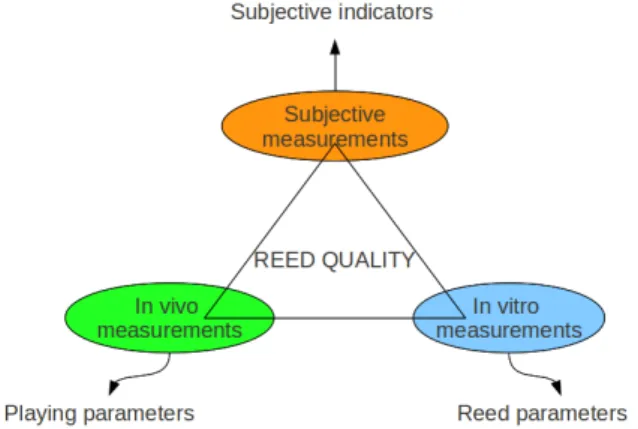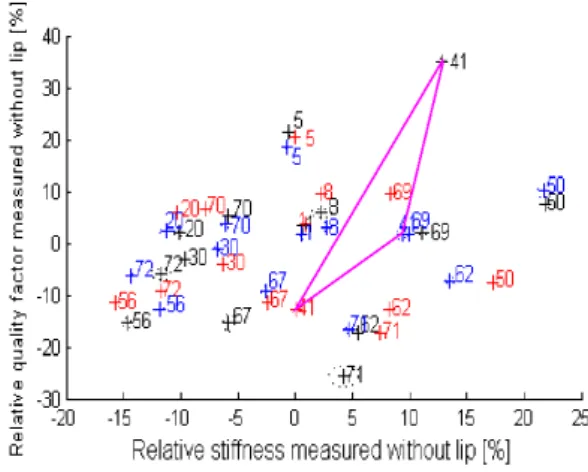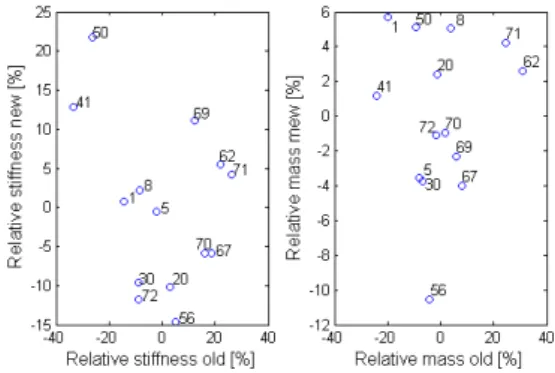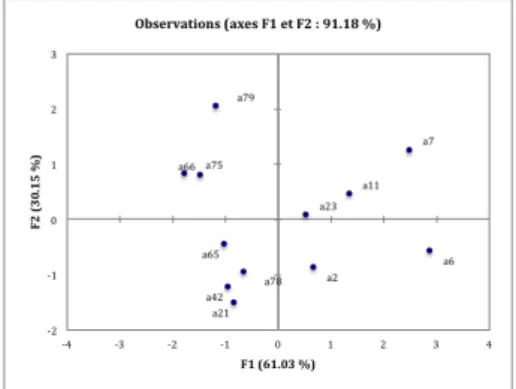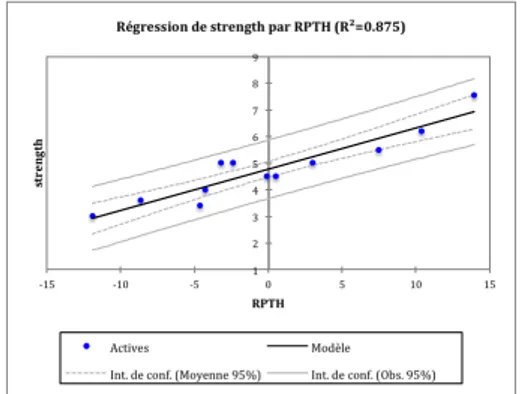HAL Id: hal-00810983
https://hal.archives-ouvertes.fr/hal-00810983
Submitted on 23 Apr 2012
HAL is a multi-disciplinary open access
archive for the deposit and dissemination of
sci-entific research documents, whether they are
pub-lished or not. The documents may come from
teaching and research institutions in France or
abroad, or from public or private research centers.
L’archive ouverte pluridisciplinaire HAL, est
destinée au dépôt et à la diffusion de documents
scientifiques de niveau recherche, publiés ou non,
émanant des établissements d’enseignement et de
recherche français ou étrangers, des laboratoires
publics ou privés.
Objective and subjective characterization of saxophone
reeds
Bruno Gazengel, Jean-François Petiot, Martin Soltés
To cite this version:
Bruno Gazengel, Jean-François Petiot, Martin Soltés. Objective and subjective characterization of
saxophone reeds. Acoustics 2012, Apr 2012, Nantes, France. �hal-00810983�
Objective and subjective characterization of saxophone
reeds
B. Gazengel
a, J.-F. Petiot
band M. ˇ
Solt´es
ca
Laboratoire d’acoustique de l’universit´e du Maine, Bˆ
at. IAM - UFR Sciences Avenue Olivier
Messiaen 72085 Le Mans Cedex 9
b
Ecole Centrale de Nantes, 1 rue de la noe, BP 92101, 44321 Nantes, France
c
Department of Physics, Czech Technical University, Technick´
a 2, 16627 Prague 6, Czech
Republic
The subjective quality of single cane reed used for saxophone or clarinet may be very different from a reed to another although reeds present the same shape and the same strength. In this work, we propose to compare three approaches for the characterization of reeds properties.
The first approach consists in measuring the reed mechanical response by the mean of a specific bench which gives equivalent dynamic parameters (mass, damping, stiffness) of the first vibration mode and the non linear stiffness of the reed. The second approach deals with the measurement of playing parameters “in vivo“, using specific sensors put on the instrument mouthpiece. These measurements enable us to deduce specific parameters in playing condition, such as the threshold pressure or the spectral centroid. Finally, subjective tests are performed with musicians in order to deduce the independent subjective criteria which characterize the quality of reeds.
Different reeds chosen for their subjective differences (rather difficult and dark, medium, rather easy and bright) are characterized by the three methods. First results show that correlations can be established between ”in vivo” measurements and subjective assessments.
1
Introduction
The musical quality of woodwind instruments such as clarinet or saxophone depends strongly on the reed quality. Quality of single cane reed may vary from a reed to another. Using our own experience of musician, we consider that 30 % of reeds in a box are good reeds, whereas 40 % are mean quality reeds and 30 % are considered as bad.
Usually, the experimental characterization of mechanical properties is performed by measuring the mechanical sti ff-ness of the reed submitted to a static force at a particular location from the tip. This measurement enables to estimate the strength of the reed which is indicated for the clarinet or saxophone player. It appears that this method is necessary to sort out the reeds for different strength and to indicate to the musician if the reed can be played with a particular mouth-piece. However this approach can not explain the great dif-ferences observed between reeds with the same strength and the same cut.
In our view, the analysis of reed quality can be divided in three parts as shown in figure 1. First axis concerns the subjective measurements of the reed and should determine how many subjective dimensions characterize the reed mu-sical quality. Second axis deals with phymu-sical measurements performed on a player (“in vivo measurements”). Last part deals with the “in vitro” measurements. It concerns the me-chanical or optical characterization of the reed.
In this paper, we present measurements performed fol-lowing these three axis for characterizing tenor saxophone reeds quality.
Figure 1: Structure of the research done on reed quality. The paper is organized as follow. Section 2 presents the experimental system which enables us to estimate the
me-chanical parameters of the reed. Results obtained with a set of 14 reeds at two different dates (repeated measurements) are compared and the efficiency of the measuring bench is discussed. Section 3 presents the ”in vivo“ measurement sys-tem and the subjective tests. Finally, the comparison between the ”in vivo” experiments and the subjective tests are pre-sented and the results are discussed.
2
Characterization of reeds by
vibroa-coustic response
2.1
Aim of the experiment
This section presents the performances of the vibroacous-tic bench used for characterizing the equivalent mechanical parameters of tenor saxophone reeds at a low sound pressure level (typically about 100 dB SPL). We present first the prin-ciple of the bench then the results, which were obtained on a set of 14 reeds measured at two different separate dates.
2.2
Vibroacoustic bench
All the measurements were performed using the exper-imental setup shown in Figure 2. Sine sweeps were gen-erated using personal computer and sent to loudspeaker via amplifier. Microphone and displacement sensor signals were recorded in the PC using data acquisition board. This setup is exactly the same as the one used previously by Gazen-gel et al[1]. Great care was taken to place each reed at the same position vertically and horizontally. Displacement sen-sor was always placed two millimeters below the tip of the reed and every time at exactly the same distance from the reed. Moreover, artificial lip was constructed using thin sil-icon strip mounted to a rigid supporting frame. Strip was 3cm wide, 7mm tall and 4mm thick. It was attached to a thin horizontal beam (an old saxophone reed) which was used to model the effect of the musicians teeth. For the measure-ments using the artificial lip, the lip was always positioned at the same vertical distance from the tip of the reed. Force between the lip and the reed was measured using the FSR (force sensing resistor) sensor and was always set to the same value, similar to the value obtained when measuring the force between the real lip and the reed on the playing musician.
Examples of frequency response measurements made with the artificial lip are presented on figure 3 and show that the first reed resonance is strongly damped as observed in [2, 3]. However the second strong resonance observed by Silva et al [3] on a artificial mouth does not appear in our experiment.
Proceedings of the Acoustics 2012 Nantes Conference 23-27 April 2012, Nantes, France
Figure 2: In vitro experimental setup.
Figure 3: Example of frequency response measurement with the use of artificial lip.
2.3
Results
Fourteen different reeds were used for the experiments. Three sets of measurements were made over a time period of one week (three different days). Every time, the frequency response of each reed was measured with and without the use of artificial lip several times. This way we can compare the results from the measurements made over a time span of few minutes (short term repeatability), compare the results from the measurements made over a time span of few days (mid term repeatability) and also by comparing our results with the several months old results of Gazengel et al [1]. We can obtain the long term repeatability.
Four different parameters (resonance frequency, quality factor, mass and stiffness) were obtained for every reed and every measurement from the frequency response curve by means of modal analysis. First, we focus on their short-term and the mid-term repeatability.
2.3.1 Short-term and mid-term repeatability
A total of nine measurements was taken for each reed without the use of the artificial lip (five measurements first day, three measurements three days later and one more mea-surement another three days later). From the meamea-surements done at the same day, mean values and standard deviations are calculated for each reed. In Figure 4 , relative Q-factor vs relative stiffness and in Figure 5, relative resonance fre-quency vs relative mass are plotted. Relative value of each parameter of i-th reed measured on j-th day is represented in 2-D space by a plus sign (+) corresponding to the rela-tive mean values of its estimated parameters. Around the (+) sign an ellipse which major and minor radii represent standard deviations in their respective parameters are plot-ted. Measurements taken on different days are represented by different colors.
Figure 4: Relative quality factor vs relative stiffness measured without the use of the artificial lip.
We can observe that short-term measurement (estimation) repeatability is generally very good and standard deviations are relatively small. Mid-term repeatability is slightly worse. With some reeds (1, 5, 8, 20) it is very good. With the rest of the reeds, the results are still quite repeatable. For two reeds the results can not be considered repeatable (blue, red and black results differ for reeds 41 and 62 on figure 4). We assume that these two reeds might have been damaged due to previous excessive use. All these results hold for estima-tion of mass, stiffness and quality factor. The only parameter for which short-term and mid-term repeatability is generally excellent for all the reeds is the resonance frequency.
In Figure 5, results of the measurements with the use of the artificial lip are presented. Measurements were per-formed with the force sensor (FSR) always placed between the reed and the lip and the lip pressure (force) was always set on the same value. The lip was always placed at the same vertical distance from the tip of the reed. Total of five mea-surements have been performed (four meamea-surements first day and one more measurement three days later). It is obvious that compared to the measurements without the use of the ar-tificial lip, shortterm repeatability of the measurements with the use of the lip is worse (standard deviations are larger). Mid-term repeatability is even worse and it is questionable whether these results could provide a characterization of the reed. Mid-term measurement (estimation) of mass and res-onance frequency is not repeatable at all and it is not clear to us why we get such a big variation for these two
param-eters. It seems that these measurements do not give us any meaningful information. At best we can say that under these measuring conditions some reeds (for ex. 69) are stiffer than others (for ex. 70).
Figure 5: Relative quality factor vs relative stiffness measured with the artificial lip.
2.3.2 Long-term repeatability
To estimate the long-term repeatability we compared our results from the measurements without the artificial lip with the data obtained in [1]. In Figure 6, new vs old measure-ments of stiffness and mass are presented. Only mean values of the estimated parameters are shown. Mean values of the first set of five measurements (measured in the first day) were used for comparison. Because the old measurement results and new measurement results differ significantly in their ab-solute values, they were normalized by their respective mean values so they can be pictured in the same graph. Figure 6 reveals that there is no obvious relationship between old and new results and it is clear that they are not repeatable at all. Moreover all parameter values were shifted significantly. Except for quality-factor all other parameters were changed significantly. Old measurements were made six months be-fore our measurements, reeds were not played during this time and were kept in dry conditions. It is not clear whether it is the amount of water contained in the reed or some other factor, but it is clear that dynamical parameters of the first resonance change greatly with time.
Figure 6: New vs old measurements of stiffness and mass.
2.4
Conclusion
“In vitro“ measurements made without the use of the ar-tificial lip performed within short time period have great
re-peatability, which suggests that the measuring technique is robust and accurate enough. Comparing the results of ”in vitro” measurements made over time period of several months however shows that the dynamical parameters of the reeds are changing significantly with time. Results from measure-ments made with the artificial lip are much less repeatable. These results do not correlate with the results obtained from measurements without the use of the artificial lip. It seems that these measurements are not repeatable enough to give us any meaningful information about the reed quality.
3
Characterization of reed subjective
quality by ”in vivo” experiments
3.1
Aim of the experiment
The aim of this experiment is to try to explain the subjec-tive quality of saxophone reeds by objecsubjec-tive parameters mea-sured ”in vivo“. First we present the experiment designed for measuring playing parameters on a musician. Then the sub-jective test is presented and the correlations with obsub-jective parameters are analyzed.
3.2
In vivo measurements principle
This experiment is designed to estimate different playing parameters ”in vivo“ which can characterize the playing of a musician and could show significant differences among dif-ferent reeds.
The experimental system enables us to measure the mouth (static) pressure and the radiated acoustic pressure at the sax-ophone horn. The mouth pressure is measured using a di ffer-ential pressure sensor Endevco 8507-C2. The acoustic pres-sure is meapres-sured using a microphone placed in front of the saxophone horn. The signals are connected to an acquisi-tion board Naacquisi-tional instruments BNC-2110 using a sampling frequency Fs = 50 kHz.
The following parameters defined in [5] are estimated as described in [1]:
• Relative Spectral Centroid (RSC), • Relative Odd Spectral Centroid (ROSC), • Relative Even Spectral Centroid (RESC), • Relative Odd/Even Ratio (ROER),
• Relative Tristimulus, 1st coefficient (RTR1), • Relative Tristimulus, 2nd coefficient (RTR2), • Relative Tristimulus, 3rd coefficient (RTR3), • Relative Tristimulus, 4rd coefficient (RTR4), • Relative Pressure Theshold (RPTH), • Mean Relative Mouth Pressure (MRMP), • Relative Efficiency (REFF).
Parameter RTR4 is the ratio between the energy of higher-order harmonics which frequency is greater than or equal to 4000 Hz and the total energy. The Pressure Threshold is es-timated following the technique described in [4]. The Mean Pressure is calculated as the mean value of the mouth pres-sure during the stationary part of the sound. All the relative parameters are estimated as described in [1].
Proceedings of the Acoustics 2012 Nantes Conference 23-27 April 2012, Nantes, France
3.3
Subjective tests
3.3.1 Choice of the reeds
12 reeds of the same brand, same cut and same strengths have been considered. All these reeds were played before doing the test and were not completely new. All the reeds were considered to be playable (not too hard, not too soft). 3.3.2 Experimental protocol
The reeds were played and assessed by an experienced saxophone player. The musician used a Reference 54 Selmer saxophone and a Vandoren V16 T8 mouthpiece. 4 descrip-tors were defined for the assessment of the reeds:
1. Strength, 2. Projection, 3. Brightness,
4. Homogeneity (this refers to the homogeneity of the reed, from the bottom to the top register).
The musician was asked to play each reed and to assess each descriptor on a 5 - levels structured rating scale (from 1: low score to 5: high score). Each reed was repeated three times and the average value of each descriptor was calculated from the three evaluations. The reeds were presented in a random order.
The musician was also asked to play a given musical phrase, which was recorded. The musical phrase used for the test is a descending arpeggio of 7 notes (C 523.3 Hz, G 392 Hz, Eb 311.1 Hz, C 261.6 Hz, G 196 Hz, Eb 155.6 Hz, C 130.8 Hz). For each reed, the arpeggio has been played five times in order to estimate the average and the standard deviation of the different objective parameters.
3.4
Results
3.4.1 Multivariate analysis of the subjective data The average subjective evaluations were analysed using standardized Principal Components Analysis. The two first factors of PCA represent 91.18 % of variance, so the evalua-tions can be considered as bi-dimensionnal. Figure 7 repre-sents the contribution of the variables, and figure 8 the posi-tion of the reeds. The first factor is mainly created by the descriptors brightness, projection and homogeneity, which are correlated. The second factor if created by the descriptor strength. Typical reeds on the first factor are a6 and a7, which are very ”bright”, ”homogeneous” and ”project“, opposed to the reeds a66 and a75. Typical reeds on the second factor are a79, very”stiff” and a21, very ”flexible“. Although the reeds have been chosen from the same brand, same cut and same mechanical strength, subjective data show great differences between reeds, which confirms the musician usual feeling concerning reed quality.
3.4.2 Multivariate analysis of the objective data The average objective variables were also analysed us-ing standardized Principal Components Analysis. The two first factors of PCA represent more than 80 % of variance: this shows high correlations between the variables (Figure 9). We can distinguish three groups of variables on the fac-torial plane, which constitute a set of correlated variables:
Figure 7: Principal Component Analysis of subjective data.
Figure 8: View of the reeds in the principal Component Analysis map.
• the variables related to the high frequency components of the sounds (RSC, ROSC, RESC, RTR3, RTR4). These variables contribute to the creation of the first factor. We notice that the variables which concern the low fre-quency components (RTR1 and RTR2) are opposite to this group of variable.
• the variables relative to the pressure (RPTH, MRMP). The relative efficiency is opposed to these variables. • the odd/even ratio ROER, which contributes to the
cre-ation of the factor 2.
To see how the subjective variables correlated with the objective variables, the four subjective variables are projected on the factorial plane as additional variables (figure 9). We noticed that: the brightness is correlated with the group of variables related to the spectral centroid. This confirms a re-sult of the state of the art. The strength is correlated with variables related to the mouth pressure and threshold pres-sure, opposite to efficiency. This result makes sense. Projec-tion and homogeneity are not well represented in the factorial plane, and it is not possible to visualise correlations. 3.4.3 Modelling of the subjective variables with
objec-tive variables
From the previous study, we selected two subjective de-scriptors, which correlates with objective variable: bright-ness and strength.
For each of these descriptors, linear regressions with the descriptor as the dependent variable and the objective criteria
Figure 9: Principal Component Analysis of the objective data.
as the independent variables, were computed. An optimisa-tion of the model, according to the average squared error, was carried out (model with only one independent variable). For the brightness, the selected variable was the tristimulus RTR4 (figure 10). The R2for the regression is 0.532.
Figure 10: Brightness plotted as a function of RT 4. For the strength, the selected variable was the relative pressure threshold RPTH (figure 11). The R2for the regres-sion is 0.875.
Figure 11: Strength plotted as a function of the relative mouth pressure threshold RPTH.
The good adjustment of the model on the data for the strength of the reed make us confident for the use of this model to predict the perceived strength of the reed.
4
Conclusion
This paper deals with the study of saxophone reed musi-cal quality. It is divided into three different parts, ”in vitro“ measurements, ”in vivo“ measurements and subjective tests. First, mechanical properties of reeds are measured ”in vitro“ using a vibroacoustic bench which enables us to es-timate the dynamic response of the reed. Results (equivalent mass, stifness and damping for mode 1) obtained at di ffer-ent dates with this bench do not show a good repeatability. This suggests that the mechanical properties of reeds change much with time due to climatic effects.
Then ”in vivo“ measurements are performed on a musi-cian playing 12 reeds (same brand, same cut, same strength). Different indicators are estimated from the mouth (static) pres-sure and the acoustic prespres-sure meapres-sured at the saxophone horn. Finally, subjective tests are performed on these 12 reeds. Results of a standardized Principal Components Anal-ysis show that the subjective space is bidimensional.
Comparison between ”in vivo“ measurement results and subjective parameters show that the perceived strength can be explained by the estimated threshold pressure in the mu-sician’s mouth. Concerning the perceived brightness, we showed that it correlates with the high frequency contents of the sounds. This result is in accordance with the state of the art. Additional works will be done to increase the quality of the model, by using more explanatory variables, and more complex regression models. Cross validation procedures will be used to assess the predictive ability of the models.
In perspective, we will define a more complex model (with more explanatory variables), estimated with more observa-tions (more reeds). A cross-validation procedure will esti-mate the predictive ability of the model.
References
[1] B.Gazengel, J.P. Dalmont, ”Mechanical response char-acterization of saxophone reeds“, Proceedings of Fo-rum Acusticum, Aalborg, Denmark, 573-578, 2011. [2] B. Gazengel, T. Guimezanes, JP. Dalmont, JB. Doc,
S. Fagart, Y. L´eveill´e: Experimental investigation of the influence of the mechanical characteristics of the lip on the vibrations of the single reed, Proceedings of the International Symposium on Musical Acoustics, Barcelona, Spain (2007)
[3] F. Silva, D. Ferrand, C. Vergez, ”Seuils d’oscillation d’un instrument de musique `a anche simple: proto-cole exp´erimental & instrumentation d’une bouche ar-tificielle“, Congr´es Franc¸ais de M´ecanique, Marseille, 24-28 aoˆut 2009
[4] B.Gazengel, J.F. Petiot, E. Brasseur, ”Vers la d´efinition d’indicateurs de qualit´e d’anches de saxophones“, Congr´es Franc¸ais d’Acoustique, Lyon, 12-16 avril 2010.
[5] Mathieu Barthet, Philippe Guillemain, Richard Kronland-Martinet, Sølvi Ystad, ”From Clarinet Control to Timbre Perceptions“, Acta Acustica united with Acustica 96, 678-689, 2010.
Proceedings of the Acoustics 2012 Nantes Conference 23-27 April 2012, Nantes, France
